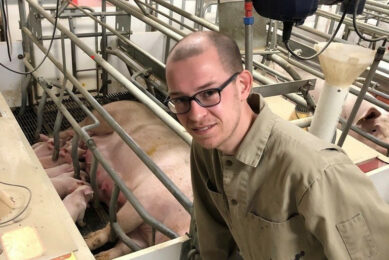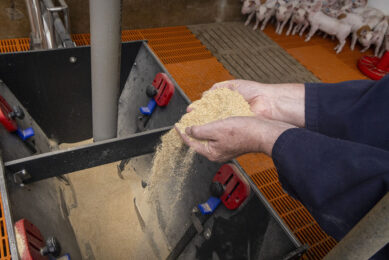Assessing digestible content of soybean meals

Soybean meal (SBM) remains the most frequently used oilseed meal in monogastric feeds. Expected to provide high quality protein and amino acids (AA) profile, SBM is included at rather high rate, particularly in broiler feeds. Consequently, SBM weighs heavily on final feed cost as well on animal performances. It’s then crucial for feed formulators to properly assess SBM’s nutritional quality.
Due to several factors including: production origins, planting environment and genetic selection; which affect the presence and concentration of nutrients and anti-nutritional factors (ANF); variability exists among soybeans. This is all the truer for SBM meal since several processing methods exist, most involving heat treatment and physical-chemical treatments, which results in a variety of products on the market. These differences impact the SBM AA digestibility and the energy content. Digestibility cannot be easily and/or accurately checked through usual quality control tests, including indirect methods. There is therefore, an obvious risk of either over- or under-estimating the nutritional value of SBM…with consequences for animal performances and formula cost.Adisseo has developed robust calibrations over several years, built from in vivo measurements of Standardized Ileal Digestibility of AA (SID aa) on adult caecectomised roosters. As well as Apparent Metabolisable Energy – corrected or not from Nitrogen (AME and AMEn) – on 22 days broilers by using near infra-red (NIR) spectroscopy for individual raw materials, including SBM. This is called Precise Nutrition Evaluation (PNE). It offers nutritionists a fast, discriminating tool to monitor variability and provide digestibility data, in order to improve the nutrient matrix for SBM. A total of 20,192 SBM samples received at feed mill level were screened in 2018 by PNE users in 57 countries around the world. Using this database, the samples could be assessed by NIR through their digestibility parameters, being as accurate as an in vivo study. This is a unique opportunity to highlight the critical parameters for SBM and develop a control plan to accurately measure SBM quality.
Total AA content rather than protein
From the usual proximate parameters, the average SBM extracted from PNE database contains: 52.4% CP, 2.4 % Fat, 4.8 CF and 7.1 % Ash on a dry matter basis; or 46.5%, 1.9%, 4.2%, 6.2% respectively, as-fed. There is heterogeneity behind these average values (Table 1). Coefficients of variation (CV %) reach 30% for fat, 20% for crude fibre content and 2.7 % for CP (equivalent to a standard deviation of 1.4 g /100g DM). This reflects the diversity of SBM suppliers used by feed mills; as well as the processing methods applied (dehulling or not, solvent extraction etc.). Regarding the AA content of SBM, it is confirmed to be rich in lysine and tryptophan, making SBM the preferred protein source to complement cereals in poultry diets; which are relatively poor in these specific AA. However, SBM protein is deficient in sulphur AAs (methionine and cystine). Variability level differs from one AA to the other: the lowest CV % is for total lysine (2.6%) and the highest for total cystine (6.2%). All other AAs vary between 3 and 4%. Which demonstrates a real need to monitor this variability by screening each SBM samples for their total AA content. This can be done at least cost and accurately with the PNE tool.
AA digestibility unpredictable
Although the CP and AA composition data are still used for identifying differences between SBM samples, they do not reflect the nutrient availability. However, calibrations have been developed for SID from the in vivo method and are accurate. As an example, calibration developed for SID of lysine reaches a correlation near of 90%with the in vivo reference method and the corresponding prediction error is around 1%. Average predicted SID AA of the studied SBM samples are listed in Table 1: the corresponding CV values range from 1.5% for SID Arg to 4.3% for Cys. Interestingly, the average SID of lysine (86.7% ± 2.3%), with more than 20 thousand data, appears to be significantly below published values (INRA (2004) 91% ± 2.8%, Bryden et al. (2009), 90%). But it’s known that all AAs can be affected by processing conditions, as demonstrated by Gonzales-Vega et al. (2011) in swine. More importantly, no correlation has been found between analysed AA content in SBM and in vivo SID AA. In the case of lysine values within the SBM samples, individual SID are weakly related to the total lysine concentration (r² = 0.12), so they can absolutely not be predicted via the Total AA profile (Figure 1). This confirms published data (Ramirez, 2011) with a large database.
5 % variability energy level
SBM also contributes to the energy level of diets. As often mentioned in literature, the wide variation in chemical and energy composition of the feedstuff makes it difficult to estimate the correct AMEn values (Alvarenga et al., 2013). Tables remain the most easily accessed prediction tool for SBM’s energy, but they do not reflect in vivo-based predictions: including the natural variations in nutrient level that arise, batch to batch and at different times. In the case of the SBM samples predicted by PNE, the average of the in vivo-based predicted AMEn value was 2,356 kcal/kg DM. However, there was significant variation: a range of 1,739 – 2,745 kcal/kg DM (CV 4.9%), equivalent to a standard deviation of 115 kcal/kg DM. Again, these results reflect the diversity between SBM source and emphasise the need for a precise estimation of the energy supplied, additionally to AA, which directly links to feed cost in poultry diets.
In vivo based quality control plan
PNE has allowed the collection of a unique and huge data base of SBM samples from feed millers – tested when arriving at the mill, with digestibility data as if the measurements had been made in vivo. Released results on AA digestibility and energy are reliable and precise. Therefore, for accurate quality control, all batches of SBM delivered to the feed mill should be thoroughly controlled and variability monitored. The PNE platform is the high valuable tool that nutritionists can routinely use, in order to update the nutritional matrix values of SBM, and to get a step closer to precise nutrition formulation.
References available upon request please contact : Elisabeth.Bourgueil@adisseo.com
Authors: E. Bourgueil, C. Gady And S. Vandeplas And P. Cerneau Adisseo












